#covid-19 for ts
Text
Despite the last 32 months of precautions, I have finally been Rona'd.
Do not recommend.
Trying to quarantine from @savitrioflight but the closed doors are making the cats very unhappy.
11 notes
·
View notes
Text
Taylor Swift only came once to Brazil, but the connection between Tayor Swift and Brazil are simply awesome. The newest thing is: EVERYTIME miss Swift released an album the Workers’ Party won the presidential elections:
2006: Debut - Workers’ Party won
2008: Fearless - There were no presidential elections
2010: Speak Now - Workers’ Party won
2012: Red - There were no presidential elections
2014: 1989 - Workers’ Party won
2017: Reputation - There were no presidential elections
2018: No album release - Bolsonaro won the elections (Workers’ Party lose)
2019: Lover - There were no presidential elections
2020: folklore and evermore - There were no presidential elections
THE THING IS Taylor is gonna to release Midnights this year AND we have a runoff of the presidential elections between Workers’ Party and Bolsonaro (let’s say a Brazillian Trump) this takes me to: TAYLOR SWIFT IS GONNA SAVE BRAZIL
#bolsonaro is a psycho#he mocked covid-19 victims#he is also a corrupt#this is a fun coincidence#but i love it#also the workers party number is 13#taylor luck number is 13#THERE ARE SO MANY COINCIDENCES#Taylor Swift is brazillian#i don't care what anyone says#shes brazil patroness#i'm not associating TS to a political party she doesn't even know i'm just joking with a crazy coincidence pls be kind to understand that#taylor swift#brazilian politics
4 notes
·
View notes
Text
I’m curious why ‘you’ll get covid eventually’ crowd has pivoted to ‘you’ve probably had COVID already and didn’t realize it”.
What exactly are you trying to prove here? Are you trying to make it completely endemic?
0 notes
Photo
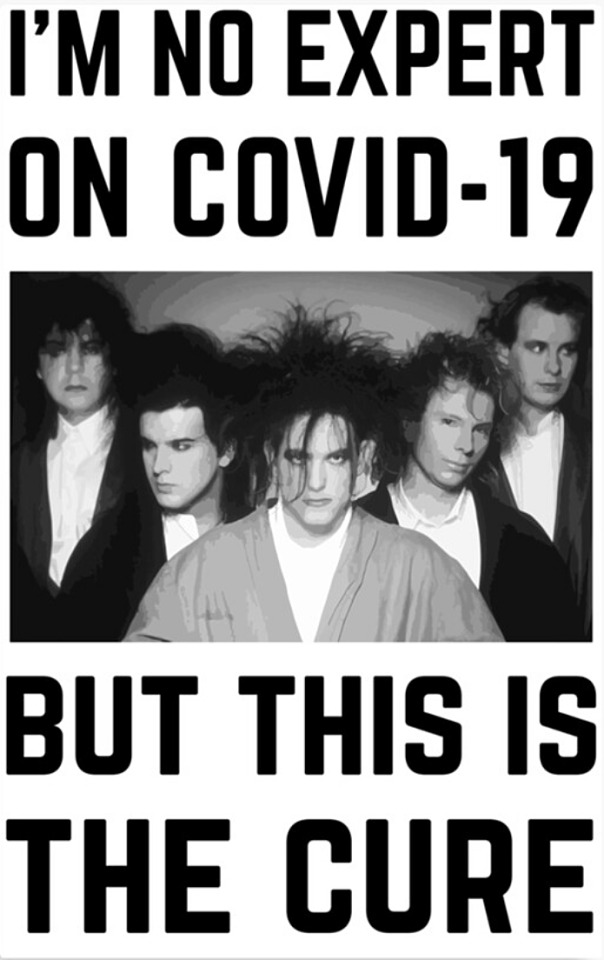
85 notes
·
View notes
Text
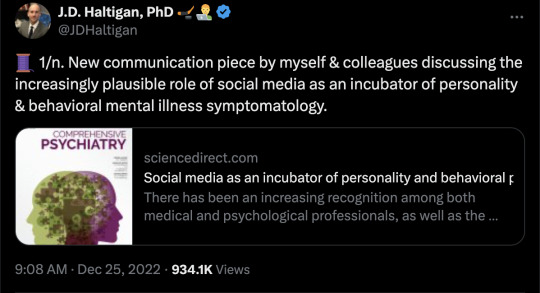
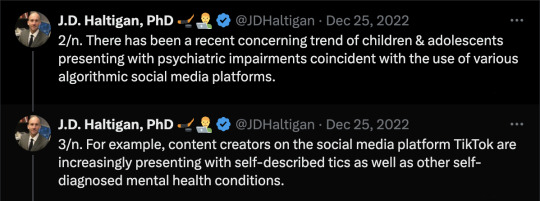
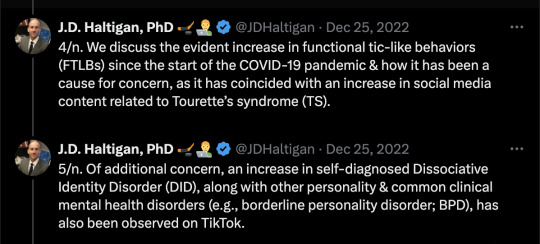


By: John D. Haltigan, Tamara M. Pringsheim, Gayathiri Rajkumar
Published: Feb 2023
Abstract
There has been an increasing recognition among both medical and psychological professionals, as well as the public media, of a concerning trend for child and adolescent users of audiovisual-based, algorithmic social media platforms (e.g., TikTok) to present with or claim functional psychiatric impairment that is inconsistent with or distinct from classic psychiatric nosology. In this short communication, we provide a detailed historical overview of this transdiagnostic phenomenon and suggest a conceptual model to organize thinking and research examining it. We then discuss the implications of our suggested model for accurate assessment, diagnosis, and medical-psychiatric treatment. We believe there is an urgent need for focused empirical research investigation into this concerning phenomenon that is related to the broader research and discourse examining social media influences on mental health.
Abbreviations
ADHD, Attention-Deficit/Hyperactivity Disorder; DID, Dissociative Identity Disorder; FTLB, Functional tic-like behaviors; MPD, Multiple Personality Disorder; NSSI, Non-suicidal self-Injury; OCD, Obessive-Compulsive Disorder; TS, Tourette's Syndrome.
--
The global burden of mental illness in children and youth is a leading cause of disability globally, accounting for ∼13% of the total burden of disease in this age group [1,2]. Notably, this estimate excluded personality disorders given limited epidemiological data at the time, suggesting that the global burden of mental illness and children and youth is likely underestimated. There are robust sex differences in the expression of common clinical, personality, and behavioral traits and disorders, especially during adolescence (e.g., females:neuroticism and depressive/internalizing disorders and symptomatology; males:aggression and antisocial/externalizing disorders and symptomatology [[3], [4], [5], [6], [7], [8], [9], [10], [11], [12]]). However, greater understanding of the overlap among their symptom expression and sex-linked prevalences, as well as their social and biological correlates is needed. Recent quantitative work examining their symptom overlap has enhanced insight into the transdiagnostic dimensional structure of common clinical and personality psychopathology [[13], [14], [15]].
At the same time that our understanding of transdiagnostic relations among common clinical and personality disorders and symptomatology has progressed, there has emerged an increasingly urgent need to understand the magnitude and developmental significance of social media use on mental health [[16], [17], [18]], especially during adolescence given it is a critical developmental window during which emotion regulation capacities are unfolding [12,16,17,[19], [20], [21], [22]]. The urgency of this need has been magnified by the emergence of the COVID-19 pandemic which has been associated with increased social media use and perceived individual social isolation and psychological/psychiatric distress [[23], [24], [25], [26], [27], [28]], including suicide-related mortality [29].
One social media site that has received increasing media and research scrutiny as a potential conduit or ‘spread vector’ for mental illness symptoms and disorders is TikTok [[30], [31], [32]]. There has been a well-documented uprise in popular content creators with self-described tics or Tourette's Syndrome (TS) and other self-diagnosed mental health symptomatology on the TikTok platform [[37], [71]] leading some to characterize the phenomenon as “TikTok's sick-role subculture” [30]. This uptick has coincided with increasing numbers of youth who have presented to clinical providers or psychiatric services during the COVID-19 pandemic with what have been termed functional tic-like behaviors (FTLBs) [31,33,34]. Similar phenomenon has also been recently chronicled with respect to dissociative identity disorder (DID) [35].
These more recent examples of mental health-related issues appearing with notable penetrance in the social media ecosystem have emerged within the context of a broader fusion and coalescence of individual self-diagnosis, including anxiety, depression, eating disorders, autism, and gender identity-related conditions on social media platforms, perhaps most notably on the social media site Tumblr during the first decade of the 2000s [36], but also Instagram and most recently on TikTok as well [[37], [38], [39]]. The continued evolution of this trend underscores an urgent need for increased understanding of the influence of social media on mental health, including its phenotypic clinical presentations and the possibility that increasingly algorithmic social media platforms may serve as a vehicle of transmission for social contagion of self-diagnosed mental illness conditions. Moreover, a greater understanding of the contributions of both personality and common clinical psychopathology to the ways in which social media platforms impact, facilitate, and ultimately inform the emerging debate about the definitions and contours of what is and is not considered mental ill-health is needed.
1. Audiovisually immersive social media: TikTok
TikTok was initially launched as a platform for users to post short clips of dancing, singing and comedy. The social media app launched in 2018 and had approximately one billion active monthly users worldwide by 2021. During the COVID-19 pandemic, this number increased. TikTok has a distinct algorithm, which allows users to receive content tailored to them, based on their preferences, interests and current state of mind. Depending on the length and type of interaction on a post, TikTok algorithms curate an audiovisually entertaining, sensory-immersive stream of personalized videos to their "For You" page.
User content on TikTok has evolved from the app's launch, with more content creators advocating for awareness surrounding issues such as feminism, mental illness, body positivity, disabilities, and gender identity. Notably, there have been many accounts that have received millions of views for their journey with their disability and/or mental illness, especially TS. These accounts have grown in popularity and their content has appeared to gain widespread traction as viewers engage with the content and learn how content creators perform everyday activities, while having tics that can largely affect their functionality in day-to-day life.
2. Before TikTok: Tumblr and the origins of online identity fandoms
Tumblr is a social media network that was founded in 2007, reaching peak user popularity in early 2014 based on the number of daily blog posts [36,40]. The creation of ‘fandoms’ (fans of a particular person, team, fictional series, etc. regarded collectively as a community or subculture) provided users who typically were seen as outcasts, a sense of community and belonging, as demonstrated by its company's mission statement; “Tumblr is a place to express yourself, discover yourself and bond over the stuff you love. It's where your interests connect you with your people” [40]. Journalist and internet historian Katherine Dee has written “Tumblr became a place for people to fantasize and build upon ideas about real identities. There was an aesthetic dimension, a dimension of roleplay, a feeling of camaraderie with others—but it was often pure fiction [41].” This identity element was also noted as a feature of social media more broadly: as Moreno et al. [39] noted “Social media also allow users to create online identities that may reflect their real identity or a newly-developing identity.” Mental health content such as eating disorders and depression, along with numerous other common clinical mental disorders, were often disclosed on Tumblr [36]. Accounts promoting eating disorders, self-mutilation, and suicide became popular and with half of Tumblr's visitor base being under the age of 25, raising concern for the potentially deleterious effects of social media use on adolescent mental health. Tumblr implemented a policy against blogs of this nature in 2012. Similar issues also manifested on the social media platform Instagram where non-suicidal self-injury (NSSI) content and corresponding NSSI-related identities became a concern [39].
3. Personality and common clinical psychopathology: mental illness as identity-selection?
3.1. Tics, Tic DO, and Tourette's syndrome (TS)
An increasing number of reports from the US, UK, Germany, Canada and Australia have noted an increase in functional tic-like behaviors (FTLB) both prior to and during the COVID-19 pandemic, coinciding with an increase in social media content related to Tourette syndrome and tics [[31], [32], [33], [34],[42], [43], [44]]. These FTLBs differ from classic Tourette syndrome (TS) both neurotypically and phenotypically. Neurotypically, FTLB age of onset (typically 12–25 years) is later in development relative to classic TS with onset in early childhood and improvement of tic behavior in late adolescence. Phenotypically, FTLBs are characterized by an abrupt and explosive presentation of symptoms over hours or days of mostly complex phonic and motor tic-like behaviors with high severity, with many patients able to provide the exact date of onset or inciting event. In contrast to the rostro-caudal evolution of motor tic symptoms which develops over years in TS, FTLBs often predominantly affect the upper limbs, with complex movements of the arms and hands, including clapping, sign language, throwing objects, banging oneself on the chest, head or thigh, or hitting other people.
In TS, motor tics usually precede verbal tics, with the most common vocal tic being throat clearing, and less than 15% of those diagnosed with TS ever developing any complex vocalizations. In contrast, complex vocalizations are a prominent feature of FTLBs, including a large repertoire of random words, phrases, or offensive statements. Tourette's Syndrome is a highly prevalent disorder in youth, affecting approximately 1% of school-age boys and 0.25% of school-age girls [45]. The mean age onset of tic symptoms is approximately 6 years of age for both males and females as is the peak clinical presentation (when received at a specialist clinic) at 10 years of age. Some studies suggest there is a small but significant difference in tic severity between boys and girls, with girls having slightly more severe and more persistent tic symptoms with a higher resolution of tic symptoms in late teens for boys [46,47].
A large majority of those demonstrating FTLBs are adolescent females, which also forms a core user group of TikTok. Patients with FTLBs are also more commonly diagnosed with anxiety and depression, than those with TS which frequently co-occurs with neuropsychiatric conditions such as Attention-Deficit/Hyperactivity disorder (ADHD) and Obsessive-Compulsive Disorder (OCD) [33,34]. FTLBs are in keeping with a Functional Neurological Disorder in the context of anxiety and depressive symptoms and diagnoses, and more broadly with affective dysregulation. Many presenting to psychiatric clinics have also noted they have seen popular videos on Tourette's syndrome and have since started sharing the same tics [32].
3.2. Dissociative identity & other mental disorders
A similar phenomenon has been observed in individuals with self-diagnosed Dissociative Identity Disorder (DID) or adjacent quasi-psychiatric terms such as “person with Dissociated Identities” and “plurals” [35,48]. Indeed, the evolution of the online culture associated with DID or multiple personality disorder (MPD) has been richly chronicled [49]. The pluralist's online culture is an umbrella moniker that includes five distinct languageidentifiers regarding the etiology of Plurality defined by Plurals themselves including: (1): Traumagenic-Adaptive; (2) Traumagenic; (3) Traumagenic-Cultural; (4) Endogenic; and (5) Exogenic [35]. Notably, the endogenic and exogenic identifiers were identifiers created ‘de-novo’ and have no relation to empirical nomenclature. Based on these identifiers, three groups of plurals have been described. While the first two groups are related to conventional psychiatric clinical interpretations of and empirical research into DID (e.g., as potentially trauma-based), the third group is a pseudo-psychiatric group that includes those who identify as plurals but as not disordered [35].
Hashtags such as #DID, as well as #borderlinepersonalitydisorder and #bipolardisorderhave received millions of views, and popular content creators post videos capturing them ‘switching alters’ (i.e., plurals). Impressions from both the lay public and clinical professionals have converged in the observation that a salient feature of this emerging DID and self-diagnosed mental illness social media posting and discourse is that it has a distinct appearance of being romanticized, glamourized, and sexualized (or possibly malingered) [[48], [49], [50], [51], [52]]. Accordingly, this may be one explanation for why many users claim to have ‘rare’ disorders like DID (with prevalence estimates ranging from 0.01% to 14% depending on sample characteristics and the methodology used to assess DID; especially among children the disorder is extremely rare [[53], [54], [55], [56]]), as well as the emergence of a ‘plurals community’ for DID. Such plurals communities include non-traditional peri-psychiatric non-disordered notions of DID that community members have created on their own and are liberated from conventional psychiatric nosology. It has been noted that non-diagnosed (or undiagnosed) claims of DID can negatively impact others in the DID plurals community who have clinically diagnosed DID and are seeking functional reintegration as a therapy endpoint [35].
4. Diathesis-stress: an integrative model of vulnerability towards understanding social media, personality-identity confusion, and psychopathology
Although many social media users and online community members will be exposed to both media and community content that reflects peri-psychiatric conditions or self-diagnosed conditions, most will not adopt peri-psychiatric behaviors or conditions and/or seek professional clinical assistance. Indeed, positive effects of online social communities for coping with stress, relationship-building, and for enhancing feelings of belonging and shared experience among people experiencing mental illness, as well as other minority and marginalized groups, have been described [35,36,38,57,58]. What is needed in our view is an integrative explanatory framework for what places a seemingly increasing subset of individuals at-risk for or more vulnerable to adopting peri-psychiatric behaviors or conditions. The diathesis-stress model of individual differences to environmental context [[59], [60], [61], [62]] provides an organizing heuristic to begin to develop such an explanatory framework. Classic diathesis-stress or vulnerability-stress models postulate that poor developmental experiences (e.g., stressful or resource-poorenvironments) are most likely to impact the development of individuals who carry vulnerability factors, which are latent diatheses that result in increased risk for psychopathology when “triggered” by exposure to negative or otherwise stressful developmental experiences. Latent diatheses reflect biological or social-cognitive predispositions to react and behave in specific ways; psychopathology reflects signs, symptoms, and behaviors associated with mental illness or inconsistent with mental health in the normative range. While not inherently stressful per se, the social media environment is a relatively novel environment in evolutionary history and the negotiation of social relationships through the scopic medium of increasingly algorithmic, audiovisual social media may pose a unique set of conditions that place individuals with latent diathesis to personality and behavioral psychopathology, particularly that defined by deficits in emotion regulation and negative emotionality (NE) [63], at increased risk for the development of psychopathology [19,36,64,65].
Relative to males, adolescent females are at higher risk for depressive and anxiety-related disorders [6], along with higher levels of negative emotionality and personality trait neuroticism [7,9]. Accordingly, one possibility in the case of ‘TikTok tics’ is that the functional purpose of FTLBs—which are disproportionately prevalent in females based on empirical data to date – is to seek affirmation and/or draw attention to oneself to acquire social capital in online communities [36,66] while simultaneously maintaining an unconventional peri-psychiatric identity that may mask feelings of anxiety, depression, and possibly lower self-esteem [19,30,67]. It is also plausible that the social stress and isolation due to the COVID-19 pandemic operated in a dual-risk capacity in addition to unique personality and behavioral factors associated with social media use and participation in online communities themselves [19,64,65,68]. In any event, what seems to be clearly indicated by the preliminary clinical, empirical, and journalistic information is that for a subset of predominately adolescent-aged female youth, use of audiovisual-based social media platforms such as Instagram and TikTok, especially at moderate and high levels, is associated with the manifestation and course of FTLBs, less self-reported levels of psychological well-being [69], increased internalizing symptomatology [70], and self-diagnosis of various mental illnesses [71]. With appropriate diagnosis and intervention, particularly identification and cognitive behavioral treatment of emotional distress, social and/or generalized anxiety and affective dysregulation, youth with FTLBs have demonstrated a decrease in severity or remission of symptoms in the short-term [72]. This pattern of successful intervention in youth with FTLBs underscores the importance of widespread awareness of the possibility of social contagion influences on mental illness and identity confusion among young people, their parents, and mental health care practitioners [30,73,74].
5. Social awareness and implications for mental health assessment
Concerning the broader question of whether social media is causally related to the rise in rates of adolescent mood disorders, self-harm, and suicide since 2010 in the USA and UK, it has been pointed out that the rise paralleled the years “when American teens were obtaining smart phones and becoming daily users of social media platforms such as Instagram” [17]. The same is true of the unique clinical presentation of FTLBs which first emerged into clinical awareness in 2019 in Germany [32], as well as with the increasing recognition of the DID-plurality community and emergent discourse [35]. More broadly, there has been a recognition of vast online ‘neurodivergence’ ecosystem in which classical mental illness symptoms and diagnoses are viewed less as mental health concerns that require professional attention, but rather as consumer identities or character traits that make individuals sharper and more interesting than others around them [49,[75], [76], [77]].
The above recognition of this ostensibly heterogeneous sociogenic illness behavior, loosely bounded by classical notions of mental health diagnoses, suggests the possibility that the increasingly algorithmic [78] and audiovisually immersive social media environment is a scopic medium [79] in which various ‘neurodivergent’ or sick role [30] identities or personas can be claimed at will, at any given moment—with no antecedent biological basis or tether to empirical reality—with positive social and emotional reinforcement and resonance from the associated online community (e.g., via the use of hashtags; user-to-user sharing and amplification of content) [36]. This social and emotional resonance may amplify and reinforce identification with the persona and may even predict later behaviors in line with it [80]. Sharing emotions, feelings, and thoughts around one's self-diagnosed mental illness identity within a solely techno-mediated scopic performative milieu in which such feelings, emotions, and beliefs are amplified may increase the likelihood that the ‘self-diagnosed’ identity is reified and incorporated into one's self-concept, regardless of its correspondence to external reality and conventional taxonomies of mental illness [36,80]. Said differently, the capacity for emotion regulation around the nature of one's self -identity is increasingly being techno-mediated externally, rather than internally within the self.
Recognizing and responding to this possibility by researchers and mental health practitioners is an urgent public health priority in our view, given extant evidence suggesting that the social media environment is a mental health risk factor for adolescents and youth struggling with elevated personality psychopathology and inchoate personal identities during the transition to young adulthood [17,19,20,22]. In addition, whether and how social media technology is a contributing force in both potentially inducing sociogenic illness while simultaneously influencing how professional mental health organizations evolve with respect to understanding and defining mental illness—thus potentially immunizing current sociogenic illness from classical diagnoses of mental illness—is crucial to take stock of in order to rigorously inform public health discourse and policy [81].
--
Also:
Abstract
Currently, we are facing a new manifestation of functional neurological disorder presenting with functional Tourette-like behavior (FTB). This study aimed to show characteristics of this phenotype presenting as an outbreak of “mass social media-induced illness” (MSMI) and to explore predisposing factors. Between 5–9/2021, we prospectively investigated 32 patients (mean/median age: 20.1/18 years, range: 11–53 years, n = 16 females) with MSMI-FTB using a neuro-psychiatric examination, a comprehensive semi-structured interview and aspects of the Operationalized Psychodynamic Diagnostic System. In contrast to tics, numbers of complex movements and vocalizations were nine times greater than of “simple” symptoms, and of vocalizations one and a half times greater than of movements. In line with our hypothesis of MSMI, symptoms largely overlapped with those presented by German YouTuber Jan Zimmermann justifying his role as “virtual” index case in current outbreak. Typically, symptoms started abruptly at a mean age of 19 years and deteriorated gradually with no differences between males and females. In all patients, we identified timely-related psychological stressors, unconscious intrapsychic conflicts, and/or structural deficits. Nearly all patients (94%) suffered from further psychiatric symptoms including abnormalities in social behavior (81%), obsessive-compulsive behavior (OCB) (47%), Tourette syndrome (TS) (47%), anxiety (41%), and depression (31%), about half (47%) had experienced bullying, and 75% suffered from coexisting somatic diseases. Our data suggest that pre-existing abnormalities in social behavior and psychiatric symptoms (OCB, anxiety, and depression), but also TS in combination with timely-related psychological stressors, unconscious intrapsychic conflicts, and structural deficits predispose to contagion with MSMI-FTB.
#John D. Haltigan#mental health#mental health issues#mental health problems#Tourette's syndrome#Tourette's#tics#dissociative identity disorder#borderline personality disorder#social media#social contagion#self diagnosis#self dx#personal identity#human psychology#psychology#sociogenic illness#mass psychogenic illness#mass sociogenic illness#religion is a mental illness
4 notes
·
View notes
Text
Tom Skinner Interview: Vessels for Music to Be Heard
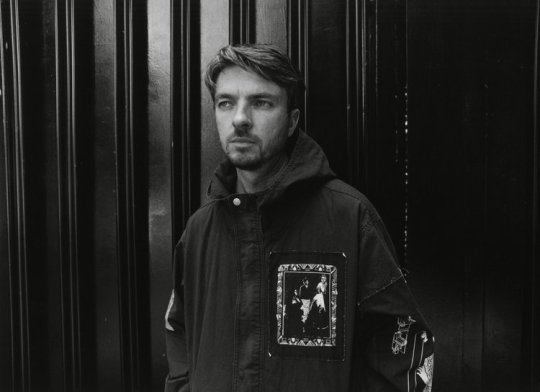
Photo by Alex Kurunis
BY JORDAN MAINZER
From the now-defunct jazz greats Sons of Kemet to best-ever Radiohead-adjacent project The Smile, Tom Skinner has not-so-quietly been one of the most versatile drummers of the past half-decade. Though he previously released his own music under the moniker Hello Skinny, earlier this month, Skinner shared his first album under his own name, Voices of Bishara (Brownswood/International Anthem/Nonesuch). The record doesn’t just exemplify Skinner as a player, but encapsulates his imaginative spirit as a listener and reinventor.
Throughout the COVID-19 lockdowns, Skinner listened repeatedly to Abdul Wadud’s 1978 solo album By Myself, privately pressed on Wadud’s label, Bishara. The Arabic name loosely translates to “the bringer of good news;” as lockdowns were lifted, vaccines administered, and live shows returned, it felt an appropriate word to reflect the genesis of what would become Voices of Bishara. A few years back, Skinner was invited to do a Played Twice session at London’s Brilliant Corners, wherein artists improvised in response to a classic album played through the venue’s audiophile system. That night, the album was Tony Williams’ Life Time; Skinner chose cellist Kareem Dayes, tenor saxophonists Nubya Garcia and Shabaka Hutchings, and bassist Tom Herbert. They had such natural chemistry that Skinner was inspired to write an album’s worth of new music, which he and the other four recorded live.
Voices of Bishara is far from a traditional jazz album, though, as Skinner returned to the recordings and edited between the instruments like his favorite disco and house producers would do. The result is an album with a tremendous sense of clearance, contrast, and opportunity for the individual players to shine. The muted, melancholy “Bishara” starts with just cello and bass before saxophone and rolling drums enter. “Red 2″, a response to Williams’ “Two Pieces Of One: Red” from Life Time, is shadowy, though Garcia’s flute shines through. Cello and chirping saxophone converse on “The Day After Tomorrow”, with Skinner’s drum rolls underneath the sighs of the woodwinds. “The Journey” and “Voices (Of The Past)” have a bit more of a groove and sway to them, Skinner’s drumming limber and snapping like a more traditional jazz or even boom bap beat. Voices of Bishara is more a retrospective of Skinner’s artistry and curatorial voice than a debut, let alone an assured mid-career album.
I emailed Skinner some questions about Voices of Bishara last month, touching on the album(s) that inspired it, responding to existing music, and composition. Read his responses below, edited for clarity.

Photo by André Baumecker
Since I Left You: Why do you think you found yourself listening to Abdul Wadud's By Myself during COVID so much? What about it resonates with you?
Tom Skinner: There’s a purity to the record. It’s a very direct and deeply personal piece of work. When you’re listening to it, it’s just you and him, no overdubs or studio trickery beyond the odd edit here and there. He’s talking directly to you, and I found that very refreshing and inspiring. In terms of the pandemic, looking back on it, I think maybe I took some solace in that level of intimacy at a time when we weren’t able to interact with other people as much as we were accustomed to. It’s also just a fucking cool record, and his playing on it is absolutely incredible. It’s loose and free with some pretty far-out improv on there but also incredibly melodic and rhythmically very interesting and groovy, too. Somehow, he manages to encompass all of my favorite things about music in one clear and concise statement.
SILY: What was your first experience or relationship with Tony Williams' Life Time?
TS: I’ve been a fan of Tony’s playing from the first time I heard him on the classic Miles Davis quintet records of the 1960’s. His own records from that time, though, always seemed a little more challenging and experimental. I first heard Spring (his second for Blue Note), and it definitely took me a while to appreciate what was going on, but as an aspiring young jazz musician, it was inspiring to hear how he was pushing himself and the music into new directions on those recordings. The thing I love about Life Time in particular is the unusual instrumentation and the fact that each track features a different combination of players. Tony doesn’t even play on the final tune. Even by today’s standards, that feels ahead of its time.
SILY: When playing for the Played Twice session and this album, why did you specifically choose Kareem, Nubya, Tom Herbert, and Shabaka?
TS: The personal connections and friendships between myself and the people I work with are at the heart of all my projects and collaborations, and this record is no exception. I have known everybody on the record for a long time, and we have a deep and rich history of performing together in different contexts. Getting this specific group together came at a time when we were all playing regularly at Brilliant Corners in various combinations, often for the Played Twice sessions. What attracted me to this particular combination of personalities and players was the scope for orchestration that it presented: Kareem’s cello and Tom’s double bass is a small string section, and Shabaka and Nubya’s tenor saxophones are the wind section, with the added possibility of them doubling on either clarinets or flutes, respectively, and then me on percussion. I also wanted to allow the musicians as much space and freedom as possible within the framework of the songs and, although there are “featured” players on certain tracks, the music was written with a collective and egalitarian approach to improvisation in mind.
SILY: "Red 2" is about a quarter of the length of "Two Pieces of One: Red" and a bit more shadowy in spirit. How did you go about coming up with your version of it, and how did you approach the differences with the original?
TS: I wasn’t approaching it with the original piece in mind at all, and I definitely didn’t want to recreate what had already been done. I wouldn’t really call it a cover, either. With our "version" of “Two Pieces of One: Red”, I wanted to try to break it down to its base elements and focus on only a very small section of the original piece, almost like a sample or a loop that you might find on a hip-hop record. In that sense, the repetition of it becomes a compositional device, too. We then used this as a jumping off point for improvisation. In addition to this idea, I wanted to play around with the sound of the recording, using hard edits between the different instruments and microphones to accentuate an almost jarring sense of space and perspective in the music.
SILY: "Voices (Of The Past)" certainly has a more retro jazz feel to it, and the drums could almost be a part of a boom bap 90's hip hop song. What voices of the past were you referencing on this track?
TS: That’s a very good question and, if I’m honest, I’m not sure I really know. Perhaps I was referencing the music I grew up listening to? Specifically a steady diet of early 90’s hip hop during my teen-age years. That’s when I got heavily into jazz, too: Miles, Coltrane, Ornette, Monk, all the classics. When you’re young, you learn very quickly and soak up so much information. All that music is digested and becomes part of your DNA. So, in a way, I feel that, subconsciously, all those things are probably filtering through.
On a deeper level, though, as musicians, when we play, we are channeling the spirits of our ancestors and forefathers. The music exists all around us, and we are vessels for it to be heard.
SILY: "Quiet As It's Kept" is the most stark track on here, comparatively speaking. How important is it for you to use empty space in your compositions?
TS: Extremely important. Silence, a rest, or a pause are as important, if not more important, than any note that’s written or played. I’m trying to tap into that more and more with my approach to playing the drums and compositionally, too. Space is the place.
SILY: Why did you decide to release this album under your name as opposed to Hello Skinny?
TS: Initially it wasn’t the plan to release it under my own name. I was just going to call it Voices of Bishara. But, for various reasons, it made more sense to release it as Tom Skinner. At first, I wasn’t keen on the idea. I’m used to hiding behind another name--like Hello Skinny or whatever--and stepping out like that felt a bit daunting. But gradually, I came around to the idea and soon came to realize that releasing music under my own name actually gives me a lot more artistic freedom. This way, I’m not tied to any particular sound, style, or group. From one release to the next, I can essentially do what I want. That feels very liberating for me going forward.
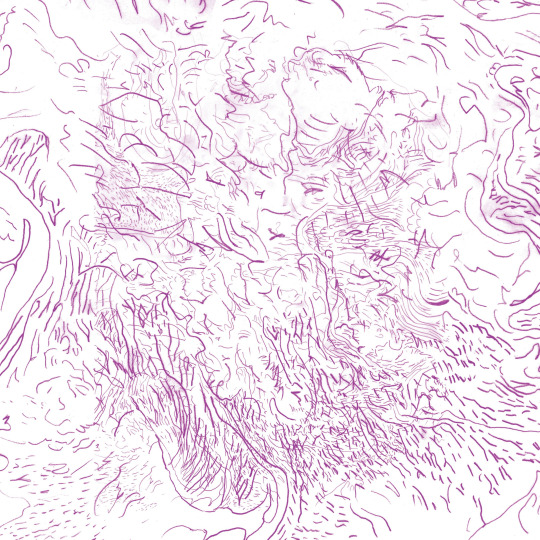
SILY: What's the story behind the album art?
TS: The album artwork and design are by the supremely talented Paul Camo. We’ve known each other for many years but only started working on projects together quite recently. This is the second sleeve he’s designed for one of my projects, the first being the Okumu, Herbert, Skinner Trio album Undone: Live at The Crypt released via Vinyl Factory in 2019.
I didn’t give Paul any specific direction; rather, I was more interested in him having complete freedom, to see how he reacted to the music creatively and allowing that to dictate the direction we took. Talking regularly with him and throwing ideas around was a very important part of the process as a whole in creating this record, and I feel like the artwork informs the music as much as vice versa, to the point where he’s now become a part of the group! Paul is a fantastic DJ and selector with a vast knowledge of all music but with a keen ear for deep jazz and improvised music. He performed with us on CDJs and samples at Church of Sound back in September. He has a regular show on NTS called We Are… which is well worth checking out. In addition to that, he runs Margate Radio (Margate is a town on the Kent coast where he is based) and is very active in the local music and art scene there.
SILY: Are you playing these songs live?
TS: We played one show in London at Church of Sound in September, and hopefully, we’ll get a chance to play some more shows next year. There are some potential opportunities on the horizon.
SILY: What's next for you?
TS: A tour across the US with The Smile that will take us right up to Christmas. I’ve started writing material for a second Bishara record. Plus, there are a few other album projects and collaborations in the works.
SILY: What have you been listening to, reading, and watching lately?
TS: Music (in no particular order): Sam Gendel, Armand Hammer, billy woods, Elucid, Low, Ingram Marshall, Robert Stillman, Loraine James, Joe Lovano’s Trio Tapestry, Julius Hemphill, Earl Sweatshirt, Coby Sey, Mica Levi, Moin, Aaron Dilloway, Lucrecia Dalt, Ohbliv, Jaimie Branch, keiyaA, Henry Threadgill, Tara Clerkin Trio, Charles Stepney, Rotary Connection, Jeanne Lee, The Beatles, Broadcast… I could go on, but we’d be here all day.
Books: The History of Bones by John Lurie and The Passengers by Will Ashon.
Film: The Hand of God by Paolo Sorrentino.
youtube
#tom skinner#interviews#brownswood#international anthem#nonesuch#brilliant corners#shabaka hutchings#voices of bishara#alex kurunis#sons of kemet#the smile#hello skinny#brownswood recordings#nonesuch records#abdul wadud#by myself#played twice#tony williams#life time#nubya garcia#kareem dayes#tom herbert#André Baumecker#bishara#miles davis#spring#blue note#john coltrane#ornette coleman#thelonious monk
5 notes
·
View notes
Text
Improving Dual Reality Democracy Polling Data
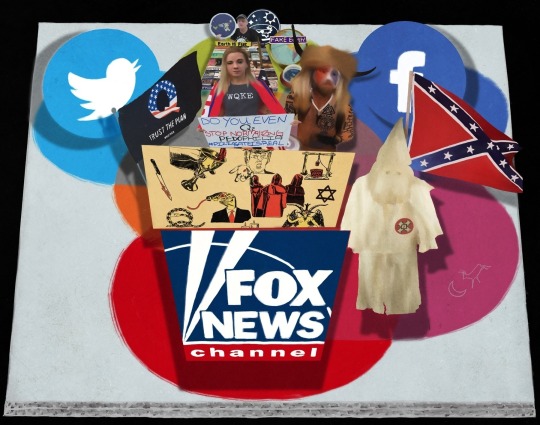
The f$&kers inside my television set seem fixated on polling data. Without capturing the associated reality bubble data, I find these polls kinda useless. I've assembled six questions that, should these little sh$ts conducting these polls add them, would append this additional demographic.
Had I a voice capable of reaching the little f$&kers, I'd go through the bother of assigning weights to the questions that follow. While Bubble One residency tends to be all or nothing (the whole f$&king population would produce identical answers), Bubble Two residency is scatter shot. The answers from those living on the surface of the bubble may not align with the answers from those living in the center (most likely because Bubble Two's reality has been fabricated and overlayed atop Bubble One reality). Weighting the questions would allow for the calculation of a threshold value for identifying Bubble Two denizens.
Anywho, here are the questions my mind shat out this morning as I was waiting for the meds to kick in:
Were the results of the 2020 presidential election manipulated via massive voter fraud?
Does the January 6th gathering at the Capitol amount to a constitutionally protected political protest?
Is the Earth flat?
Was the production and distribution of the COVID-19 vaccine in response to a global pandemic?
Are Democratic Party members and Hollywood elites secretly running a pedophile ring that's trafficking children to be abused and ultimately cannibalized?
Is Q a patriot?
2 notes
·
View notes
Text
GLOBAL CERTIFICATION FOR TELEHEALTH SERVICES
This article will highlight the challenges faced and overcome to obtain a global ISO 13131 Certification exclusively for Telehealth Services and its implications.
With telehealth now becoming an integral component of the healthcare delivery system, maintaining high quality, with systems and processes, in a future ready, technology-enabled remote healthcare milieu becomes mandatory. With geography becoming history, distance has become meaningless. Various stakeholders with diversified backgrounds constitute the telehealth eco system. Cultural and socioeconomic differences notwithstanding, it is essential that the whole world talks in the same language, as far as actual deployment of telehealth is concerned. Formulating dynamic standards implies seeing the Big Picture and understanding the nitty gritty as well The global ISO 13131 Certification exclusively for telehealth Services fulfils these objectives.
For decades, Telemedicine/telehealth services were not centre stage in the healthcare deliverysystem. Covid -19 changed this. The world has now accepted that the original forced lockdown- enforced acceptance of Remote Health Care will become the new normal even after the pandemic is de notified. Universal acceptance increases the responsibility of all healthcare providers deploying technology to ensure constant high quality while bridging the urban-rural health divide.
Quality is never an accident. It is always the result of sincere effort, intelligent direction, and skilful execution. Henry Ford opined that quality means doing it right when no one is looking, but in the real world this is difficult to implement. ISO certification ensures that “Big Brother” is watching all the time. The necessity for re-certification is like the Sword of Damocles hanging above us. It drives home the message that quality is everyone’s responsibility at all times and not during the audit alone. One has to keep running to stay where one is. To maintain the initial global recognition, maintaining quality needs to become a habit, a unique opportunity to transform one’s DNA if necessary. Success is the sum of small efforts, repeated day-in and day-out. Standardising systems, processes, documentation and re-documentation alone will ensure providing quality remote healthcare for anyone, anytime anywhere..
ISO 13131 - An Overview
The International Standards Organization (ISO), TC 215 Health Informatics Committee, developed a Technical Specification, ISO/TS 13131 Telehealth Services, based on a risk and quality management approach. This standard supports healthcare planning, service and workforce planning, organisation responsibilities and financial and IT management. ISO was established in 1947 in Geneva, Switzerland. An Independent, non-governmental international organisation, ISO develops standards that are recognised and respected globally. It brings experts together to improve quality and provide worldclass healthcare services. Experts are from 166 national standard bodies. ISO standards are developed by various advisory groups. Presently ISO has 255 technical committees, 515 subcommittees, and 2498 working bodies. Since 1947, ISO's technical experts have created more than 18,800 standards for all possible business. ISO standards ensure that administration and product/work flow systems are carried out legally, safely and effectively. ISO technical experts have developed several assessment protocols to ensure that certified organisations apply these guidelines in their workplace. The approved protocols aid organisations to ensure that their frameworks, devices and workforce comply with ISO standards. ISO 13131 provides recommendations on guidelines for telehealth services deploying Information and Communication Technology (ICT) to deliver quality healthcare services.
Implementing ISO/TS 13131 means facilitating cooperation and interoperability of its different health systems to ensure quality telehealth services. It also ensures a reliably high standard of service, irrespective of where a person lives, across the globe. This standard provides guidelines for developing quality plans and managing company resources, while putting the right policies in place to safeguard clients’ private data. Securing ISO 9001 for quality management and ISO 27001 for information security management reduces the complexity involved in getting the IOSO 13131 branding.
Why get certified?
The decision to get a time consuming, labor-intensive and expensive certification is the determination to set a benchmark in the telehealth sector. If a leading market player faces competition, the company needs reassurance that its high-quality standards would provide a stamp of recognition distinguishing it, from its competitors. Pioneers in the field, set conditions of competition, to prevent some potentially harmful practices of others, from compromising the reputation of all. Considering risks involved in securing patients’ data privacy, IT systems and processes need to be stringent conforming to security legislation. A preliminary gap analysis is initially conducted and deficits if any addressed, to fulfil specific criteria required for ISO/TS 13131. Beneficiaries draw confidence from a stringent certification process. ISO standards help organisations comply with new regulatory requirements, enhancing efficiency of internal processes and quality of remote health services provided. Documenting the much needed framework necessary for supply of services, improves value of the product. The more diverse and competitive the market, the more guidance consumers need, to ensure they are purchasing an excellent cost effective service. International Standards helps maintain a healthy competition in the marketplace.
Right quality metrics are identified. This information is made available to patients, health systems and providers. Consumers are helped to gauge telehealth providers. Healthcare workers and systems need feedback for continuous improvement. Best practices for virtual care need to be standardised, notified and applauded so that it will be increasingly sought. With the pandemic disrupting in-person care, virtual healthcare needs to be prioritised. The time to define, implement and enforce quality in all aspects of telehealth is not tomorrow but today. Formal certification by an international organisation requires hundred percent fulfilment of stringent criteria . This pre supposes commitment of a very high order and the realisation that excellence is always a moving target. One can never ever rest on one’s laurels. We need to keep running to stay where we are.
What is the Certification about?
ISO / TS 13131 is based on a risk and quality management approach allowing a broader approach to generate detailed guidelines required by a particular service. The class of standards provide flexible, general guidelines supporting innovation in healthcare. These include financial management and service, workforce and healthcare planning in addition to healthcare organisation responsibilities, facilities, technology, and information management. All existing national and international standards including standards for safety, quality and risk in health are evaluated. Standards overcome barriers in knowledge sharing. Community interest is promoted ahead of sectional interests. Often local needs, conflicting business models, intellectual property and policies have to be balanced against national and global interests. Specific guidelines including technical standards are available for clinical specialties using telehealth. However, these are at the most national. Global Standards add credibility, standardise approaches and decrease liabilities. Guidelines in the ISO/TS 13131 specification are designed to support telehealth services offered by a healthcare organisation and healthcare professionals. The specification is used as a tool customised for each healthcare setting. The healthcare professional or healthcare third party is required to possess competencies necessary for providing healthcare remotely. Appropriate minimum professional standards are applied in assessment of required competencies.
Standards in ISO 13131
These specifically deal with financial, facilities, operations, technology, and information management, service and technical support, service delivery and infrastructure deployment. The ISO/TS 13131 specification provides useful guidelines to assist the development of telehealth services, but it remains the job of each organisation to develop appropriate guidelines for each health service. Transitioning from face to-face delivery of health services to telehealth requires managing safety and quality in a virtual environment.
Role of Quality and Quality Management Systems (QMS) in Telemedicine
Proof of quality is a precondition requested by principals, prior to placing an order. Quality of services/products is important in all services provided by organisations. Quality should conform with requirements defined by customers.Better the service quality more the utilisation. In telehealth the focal point is always the patient. Comprehensive information about content of services provided, formal authorisation before transfer of confidential patient data to a third party and regular customer satisfaction surveys are key requirements of a QMS.Third party auditing and certification of the system, give a measurable value. Safeguarding legal compliance with priority on data safety, cost effectiveness, involvement of employees and customer satisfaction are key ingredients to fulfil needs of all stakeholders in tele-monitoring applications.
Key Requirements for ISO 13131 Certification for telehealth Services
• Management of all telehealth processes by the healthcare organisation
• Management of financial resources to support telehealth services
• Processes relating to staff responsibilities
• Provision of infrastructure facility for telehealth service organisations
• Management of Information and Technology resources used in telehealth services
Guidelines in ISO/TS 13131
• Service planning ensures that appropriate, accessible and quality healthcare services are provided to patients.
• Workforce planning ensures that managers, clinical and technical staff are qualified and skilled to provide safe and high quality services.
• Healthcare planning includes planning, designing and implementation of processes, clinical and technical guidelines, risk management and medical record management.
• Responsibilities of Stakeholders: Key stakeholders in the telehealth system (Healthcare providers and beneficiaries) should be competent to use technologies associated with telehealth services. Organization is responsible to provide safe and quality services.
Safety and quality risks in the use of telehealth
• Financial management is required to provide sufficient funding for telehealth services.
• Facilities management must ensure that adequate facilities are provided in telehealth services, including infrastructure and technical devices.
• Technology management ensures that telehealth services are equipped with ICT to deliver quality healthcare. Transmitting healthcare information and procedures relating to data security and data privacy are also equally important
Read More: https://www.europeanhhm.com/information-technology/global-certification-for-telehealth-services
#TelehealthCertification#HealthTech#Telemedicine#GlobalHealth#DigitalHealth#TelehealthStandards#CertifiedTelehealth#HealthcareTechnology#TelehealthQuality#GlobalHealthcare#TelehealthAccreditation#TelehealthProviders#PatientCare
0 notes
Text
Recession Fears Re-Emerge As UK Economy “Close To Stalling” In July - TS Partners
Recent months, it is fair to say, have been ones of ups and downs for many UK business owners, who have been anxious to see reasons for optimism. The UK did at least avoid what had once been a widely anticipated recession in late 2022; however, worries have since been reignited that this could come to pass during the second half of 2023 or early 2024 instead.
The reasons for such concerns were evident in the findings of S&P Global and the Chartered Institute of Procurement & Supply (CIPS)’s recent polling of firms.
As reported by the i newspaper, the companies questioned said that business had been sluggish for them recently, following the adverse impacts of climbing interest rates, persistently high inflation, and customers becoming ever-more cautious.
Sure enough, the survey discovered that although industrial output did still go up in July, it did so at its slowest pace since January.
No longer a question for some of “if the UK economy will enter recession, but for how long”
S&P Global chief business economist Chris Williamson observed about the data: “Rising interest rates and the higher cost of living appear to be taking an increased toll on households, dampening a post-pandemic rebound in spending on leisure activities.”
He continued: “The UK economy has come close to stalling in July which, combined with gloomy forward-looking indicators, reignites recession worries.”
And there was agreement on this stance from CIPS economist Dr John Glen, who said “the biggest concern is increasingly not if the UK economy will enter recession, but for how long.”
And there are certainly plenty of other metrics out there indicating that many individuals and organisations utilising expert accounting services in Newton Abbot – such as our own here at TS Partners – may shortly have to brace for recession.
It was reported on 25th July, for example, that the pound had undergone seven consecutive days of falls against the US dollar, which was its worst run since March 2020, the month the COVID-19 crisis first seriously hit the UK.
Furthermore, the EY Item Club recently issued a warning that rising interest rates are set to negatively impact the UK’s economic growth in 2024. The economic forecasting group lowered its prediction of UK growth next year to 0.8%, compared to the 1.9% it had forecast in April. And it reduced its expectations of 2025 growth, too, from 2.3% to 1.7%.
Our expertise can help ensure your business remains on a steady course
For great numbers of UK companies, then, it looks like next year will be at least as testing for them as 2023 has been. This, in turn, could give you all the more reason to double-check that your organisation is working alongside the most suitable provider of expert accounting services in Newton Abbot.
Reach out to your local TS Partners office today, to discuss how our solutions in relation to accounting, bookkeeping, payroll, and more could help put your business in the optimal position for success throughout the months and years ahead.
0 notes
Photo

Turkish delivery startup Getir to exit Italy, Spain and Portugal
Ultra-fast grocery delivery startups like Getir boomed during the COVID-19 pandemic but have been hit by consumers' stronger than anticipated return to shopping in stores.
https://economictimes.indiatimes.com/tech/startups/turkish-delivery-startup-getir-to-exit-italy-spain-and-portugal/articleshow/102177936.cms
0 notes
Text
Synthetic Biology Market Demand, Growth Rate, Trends & Forecast: 2028
Global Synthetic Biology Market by Tools (Oligonucleotides, Enzymes, Synthetic Cells), Technology (Gene Synthesis, Genome Engineering), Application (Tissue Regeneration, Biofuel, Consumer Care, Food & Agriculture, Environmental), and Region (North America, Europe, Asia-Pacific, Middle East and Africa and South America)
The Global Synthetic Biology market size is projected to reach a CAGR of 9.8% from 2022 to 2028.
Synthetic Biology is a branch of biotechnology that encompasses various aspects like set of concepts, approaches, and tools within biotechnology which could be used for the modification or creation of biological organisms. It deals with the redesigning and engineering of the organisms in such a way that they are useful for a particular problem in medicine or agriculture.

Research and development in the sector long with the surged funding are some of the factors that have supported long-term expansion for Global Synthetic Biology Market.
COVID-19 had a positive effect on the market, as the clinical developments and research was very prominent in the sector.
Get the Free Research Sample Copy: https://www.delvens.com/get-free-sample/synthetic-biology-market-trends-forecast-till-2028
Regional Analysis
North America is the most rapidly growing market and offers a huge opportunity for the industry, whose growth is driven by the presence of key players in the region and the increased expenditure on the research and developmental activities.
Key Players
Carl Zeiss AG
Creaform Inc.
Eley Metrology
FARO Technologies, Inc.
Hexagon AB
Keyence Corporation
Metronor
Mitutoyo Corporation
Nikon Metrology
Tokyo Seimitsu Co. Ltd
Make an Inquiry Before Buying: https://www.delvens.com/Inquire-before-buying/synthetic-biology-market-trends-forecast-till-2028
Recent Developmen ts
In January 2021, Frontia GlutenEx was brought into the market by Novozymes.
In February 2021, Merck joined hands with BioNTech for the supply lipids for the production of Pfizer-BioNTech COVID-19 Vaccine (BNT162b2).
Reasons to Acquire
Increase your understanding of the market for identifying the best and suitable strategies and decisions on the basis of sales or revenue fluctuations in terms of volume and value, distribution chain analysis, market trends and factors
Gain authentic and granular data access for Global Synthetic Biology Market so as to understand the trends and the factors involved behind changing market situations
Qualitative and quantitative data utilization to discover arrays of future growth from the market trends of leaders to market visionaries and then recognize the significant areas to compete in the future
In-depth analysis of the changing trends of the market by visualizing the historic and forecast year growth patterns
Direct Order for the Research Report at: https://www.delvens.com/checkout/synthetic-biology-market-trends-forecast-till-2028
Report Scope
Global Synthetic Biology Market is segmented into Tool, Technology, Application and region.
On the basis of Tool
Oligonucleotides and Synthetic DNA
Enzymes
Cloning Technologies Kits
Synthetic Cells
Chassis Organisms
Xeno-nucleic Acids
On the basis of Technology
Gene Synthesis
Genome Engineering
Sequencing
Bioinformatics
Site-directed Mutagenesis
Cloning
Measurement and Modeling
Microfluidics
Nanotechnology
On the basis of Application
Medical Application
Pharmaceuticals
Drug Discovery and Therapeutics
Cancer Detection & Diagnostics
Other Drug Discovery and Therapeutic Applications
Artificial Tissue and Tissue Regeneration
Bio-synthesis
Stem Cell Regulation
Other Tissue and Tissue Regeneration Applications
Industrial Applications
Biofuel and Renewable Energy
Biomaterials and Green Chemicals
Industrial Enzymes, by Application
Textile Industry
Paper Industry
Consumer Care Industry
Skin Care & Cosmetics
Other Consumer Care Products
Other Industries
Food & Agriculture
Environmental Applications
Bioremediation
Biosensing
On the basis of Region
Asia Pacific
North America
Europe
South America
Middle East & Africa
Browse For More Trending Reports:
About Us:
Delvens is a strategic advisory and consulting company headquartered in New Delhi, India. The company holds expertise in providing syndicated research reports, customized research reports and consulting services. Delvens qualitative and quantitative data is highly utilized by each level from niche to major markets, serving more than 1K prominent companies by assuring to provide the information on country, regional and global business environment. We have a database for more than 45 industries in more than 115+ major countries globally.
Delvens database assists the clients by providing in-depth information in crucial business decisions. Delvens offers significant facts and figures across various industries namely Healthcare, IT & Telecom, Chemicals & Materials, Semiconductor & Electronics, Energy, Pharmaceutical, Consumer Goods & Services, Food & Beverages. Our company provides an exhaustive and comprehensive understanding of the business environment.
Contact Us:
UNIT NO. 2126, TOWER B,
21ST FLOOR ALPHATHUM
SECTOR 90 NOIDA 201305, IN
+44-20-8638-5055
0 notes
Photo
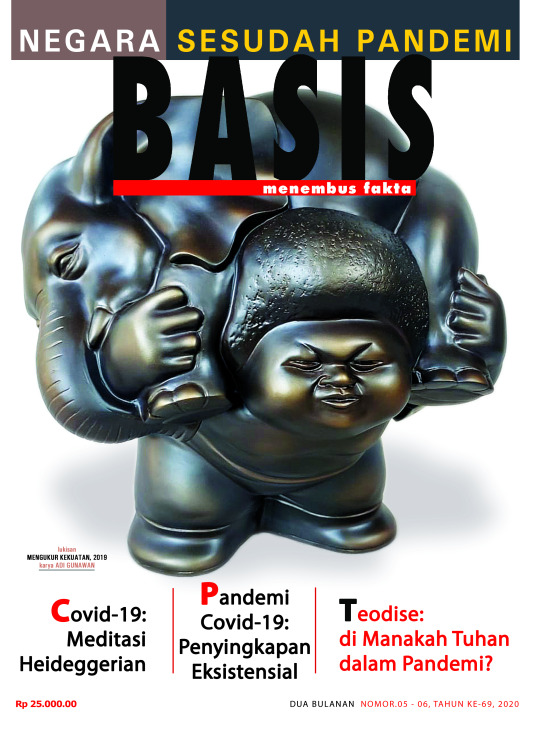
Majalah Basis No. 05-06, 2020
0 notes
Text
Dj Sbu: Biography, Age, Early Life, Education, Family, Girlfriend, Career, Awards & Nominations, Business, Philanthropy, Controversy, Net Worth
Dj Sbu had a prominent role at YFM from 2005 until 2010, where he established his brand and became a respected businessman. He is now the sole founder of his energy drink called MoFoya. Additionally, he is an accomplished writer and has published books under his educational organization, Leadership 2020, which focuses on essential aspects of business and leadership.
During his career, Dj Sbu worked as a radio and television host. He gained popularity through hosting over 100 episodes of “Friends Like These,” which helped expand his fan base. He was also a co-owner of TS Records, a record label that closed down in 2017.
Dj Sbu Age and Education
Dj Sbu, whose real name is Sibusiso Leope, was born on May 28, 1977, making him 42 years old. He grew up in Tembisa and later moved to Pretoria for his education. He attended Welamlambo Primary School and Central Secondary School, where he furthered his studies. He pursued Sound Engineering at African Media University and later studied electrical engineering at Technikon Witwatersrand University.
Dj Sbu Family
In terms of relationships, Dj Sbu used to date Disebo Makatsa, with whom he has a child named Waratwa Leope. However, he is currently known to be in a relationship with Boitumelo Mahlase.
Dj Sbu Career
Dj Sbu’s career began in 1998 at Tembisa Info Radio, a community radio station, where he produced and hosted popular weekend shows. In 2000, he joined YFM and worked as a producer and host for various shows, including “Beauty and the Beast” with Angela Ludek. He also ventured into acting, appearing in TV series like “Generations” and “Isidingo,” as well as films like “Hang Time” and “It Rained Last Night.”
Throughout his career, Dj Sbu continued to expand his presence in the entertainment industry. He became the host of the reality show “Friends Like These” and a co-owner of TS Records. He also released several albums as a musician, including “Y-Lens Vol. 1” in 2006, “Sound Revival” in 2011, “Sound Revival Vol. 2” in 2012, and “MoFaya” in 2014.
Dj Sbu Awards
Dj Sbu has received numerous awards for his contributions to the South African music industry, including the South African Music Award for Artist of the Year in 2004 and the Metro FM Award for Record of the Year in 2016.
Apart from his music and entertainment ventures, Dj Sbu has been involved in business. He co-owned TS Records, which signed notable artists like Zahara, and eventually shut down in 2017. Afterward, he founded his energy drink brand, MoFaya, and sold 26% of the production to Coca-Cola. Dj Sbu employs non-traditional marketing methods, selling his energy drink through walk-ins and random roadside sales.
Dj Sbu Philanthropy
As a philanthropist, Dj Sbu has made a positive impact. He has assisted students in need, provided Covid-19 donations, and helped homeless people in Johannesburg’s CBD.
Dj Sbu Controversy
Dj Sbu has also faced controversies throughout his career. He was suspended by YFM in 2008 for not following playlist guidelines and later publicly criticized MTV Base for their treatment of local artists. Additionally, he was involved in the Mzekezeke controversy, where rumors circulated about his alleged use of double identities. There was also controversy surrounding TS Records, as Zahara accused the record label of financial abuse and unpaid royalties.
Dj Sbu Networth
With his contributions to the music industry, radio hosting, and various business ventures, Dj Sbu’s net worth is estimated to be over R27 million
Read the full article
0 notes
Text
Dj Sbu: Biography, Age, Early Life, Education, Family, Girlfriend, Career, Awards & Nominations, Business, Philanthropy, Controversy, Net Worth

Dj Sbu had a prominent role at YFM from 2005 until 2010, where he established his brand and became a respected businessman. He is now the sole founder of his energy drink called MoFoya. Additionally, he is an accomplished writer and has published books under his educational organization, Leadership 2020, which focuses on essential aspects of business and leadership.
During his career, Dj Sbu worked as a radio and television host. He gained popularity through hosting over 100 episodes of "Friends Like These," which helped expand his fan base. He was also a co-owner of TS Records, a record label that closed down in 2017.
Dj Sbu Age and Education
Dj Sbu, whose real name is Sibusiso Leope, was born on May 28, 1977, making him 42 years old. He grew up in Tembisa and later moved to Pretoria for his education. He attended Welamlambo Primary School and Central Secondary School, where he furthered his studies. He pursued Sound Engineering at African Media University and later studied electrical engineering at Technikon Witwatersrand University.
Dj Sbu Family
In terms of relationships, Dj Sbu used to date Disebo Makatsa, with whom he has a child named Waratwa Leope. However, he is currently known to be in a relationship with Boitumelo Mahlase.
Dj Sbu Career
Dj Sbu's career began in 1998 at Tembisa Info Radio, a community radio station, where he produced and hosted popular weekend shows. In 2000, he joined YFM and worked as a producer and host for various shows, including "Beauty and the Beast" with Angela Ludek. He also ventured into acting, appearing in TV series like "Generations" and "Isidingo," as well as films like "Hang Time" and "It Rained Last Night."
Throughout his career, Dj Sbu continued to expand his presence in the entertainment industry. He became the host of the reality show "Friends Like These" and a co-owner of TS Records. He also released several albums as a musician, including "Y-Lens Vol. 1" in 2006, "Sound Revival" in 2011, "Sound Revival Vol. 2" in 2012, and "MoFaya" in 2014.
Dj Sbu Awards
Dj Sbu has received numerous awards for his contributions to the South African music industry, including the South African Music Award for Artist of the Year in 2004 and the Metro FM Award for Record of the Year in 2016.
Apart from his music and entertainment ventures, Dj Sbu has been involved in business. He co-owned TS Records, which signed notable artists like Zahara, and eventually shut down in 2017. Afterward, he founded his energy drink brand, MoFaya, and sold 26% of the production to Coca-Cola. Dj Sbu employs non-traditional marketing methods, selling his energy drink through walk-ins and random roadside sales.
Dj Sbu Philanthropy
As a philanthropist, Dj Sbu has made a positive impact. He has assisted students in need, provided Covid-19 donations, and helped homeless people in Johannesburg's CBD.
Dj Sbu Controversy
Dj Sbu has also faced controversies throughout his career. He was suspended by YFM in 2008 for not following playlist guidelines and later publicly criticized MTV Base for their treatment of local artists. Additionally, he was involved in the Mzekezeke controversy, where rumors circulated about his alleged use of double identities. There was also controversy surrounding TS Records, as Zahara accused the record label of financial abuse and unpaid royalties.
Dj Sbu Networth
With his contributions to the music industry, radio hosting, and various business ventures, Dj Sbu's net worth is estimated to be over R27 million
Read the full article
0 notes
Text
WHO Việt Nam: 'Cần lập kế hoạch ứng phó Covid trong dài hạn'

TS. Angela Pratt, Trưởng đại diện Tổ chức Y tế Thế giới (WHO) tại Việt Nam, cho rằng cần lập kế hoạch ứng phó trong dài hạn khi Covid-19 không còn là tình trạng y tế khẩn cấp toàn cầu.
Chia sẽ từ VNE: Sức khỏe - VnExpress RSS https://vnexpress.net/who-viet-nam-can-lap-ke-hoach-ung-pho-covid-trong-dai-han-4601817.html
0 notes
Text
Buổi lễ tốt nghiệp năm 2022 của Trường Cao đẳng Y Khoa Phạm Ngọc Thạch đánh dấu một mốc quan trọng của sinh viên Nhà trường. Các em đã trải qua hành trình của sự cố gắng trong học tập, rèn luyện, trong đó có khó khăn, vất vả và cả những gi��t mồ hôi. Ghi nhận sự nỗ lực đó của các em, buổi lễ hôm nay như một lời tri ân sâu sắc gửi tới quý thầy cô, phụ huynh và các em sinh viên.
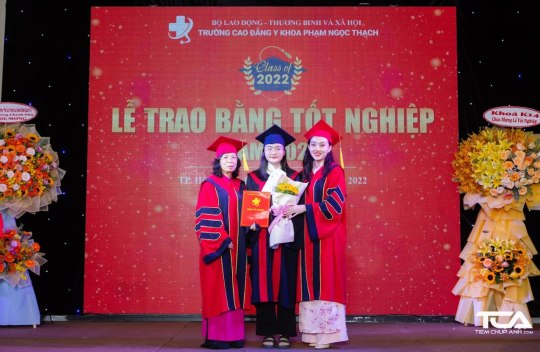
Phát biểu tại buổi lễ, hiệu trưởng nhà trường PGS-TS Phạm Thị Lý nhiệt liệt chúc mừng sinh viên Nhà trường hoàn thành tốt chương trình học tập và rèn luyện để trở thành tân cử nhân trong lĩnh vực Y Dược. Dù trải qua 3 năm học khó khăn, vất vả do đại dịch covid 19 với TP Hồ Chí Minh nơi riêng và Việt Nam ta nói chung, nhưng các em đã không ngừng vươn lên để cùng với Nhà trường hoàn thành tốt sứ mệnh được giao.Trải qua hơn 14 năm thành lập, trường Cao đẳng Y Khoa Phạm Ngọc Thạch đã có nhiều thế hệ sinh viên tốt nghiệp chất lượng cao. Với thành quả ngọt ngào đó giúp cho trường đã có vị thế nhất định và được đánh giá là ngôi trường có chất lượng giáo dục uy tín và đáng để theo học.Với mong muốn sinh viên tốt nghiệp tiến bộ và thành công hơn nửa, cô Phạm Thị Lý nhắn nhủ: Các em cần phải nỗ lực hơn nữa trong học tập để có việc làm ổn định. Luôn trau dồi thêm về đạo đức nghề nghiệp để trưởng thành. Nhà trường sẽ luôn nỗ lực trong công cuộc trồng người, tạo ra thế hệ thầy thuốc ưu tú cho đất nước.Buổi lễ tốt nghiệp năm 2022 của Trường Cao đẳng Y Khoa Phạm Ngọc Thạch sẽ ghi dấu sự trưởng thành với những thành quả ngọt ngào của các bạn sinh viên sau 1 quá trình thời gian học tập miệt mài và rèn luyện dưới mái trường. Chúc mừng các bạn đã hoàn thành chương trình học của mình và đạt thành công cao trong con đường sự nghiệp trước mắt!
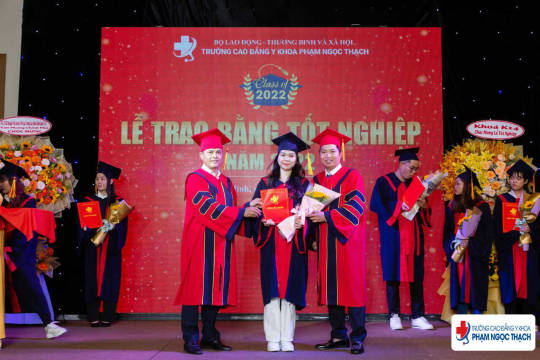

0 notes